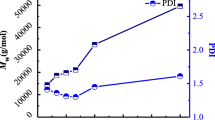Abstract
Enzymatic polymerization can offer metal-free routes to polymer materials that could be used in biomedical applications. To take advantage of the unique properties of ionic liquids (ILs) for enzyme stability, monocationic ionic liquid (MIL) and dicationic ionic liquid (DIL) were used to promote the ring-opening polymerization of ε-caprolactone (ε-CL) using Candida antarctica lipase B as catalyst. Considering the molecular weight (M n ) and reaction yield of the resulting polymer (PCL), high density and viscosity of ILs would be good, especially in the case of DIL. With the same total alkyl chain length, the density and viscosity of [C4(C6Im)2][PF6]2 were higher than that of [C12MIm][PF6]. Using a lipase/CL/ILs ratio of 1:20:20 (by wt) for 48 h at 90 °C, the highest M n and reaction yield of PCL were 26,200 g/mol and 62 % with [C4(C6Im)2][PF6]2, while the M n and reaction yield of PCL obtained in [C12MIm][PF6] were 11,700 g/mol and 37 %.






Similar content being viewed by others
References
Bonhôte P, Dias AP, Papageorgiou N, Kalyanasundaram K, Grätzel M (1996) Hydrophobic, highly conductive ambient-temperature molten salts. Inorg Chem 35:1168–1178
Dean JA (1991) Lange’s handbook of chemistry. Science Press, Bei**g, pp 10–97
Feng J, He F, Zhuo RX (2002) Polymerization of trimethylene carbonate with high molecular weight catalyzed by immobilized lipase on silica microparticles. Macromolecules 35:7175–7177
Ghatee MH, Zare M, Moosavi F, Zolghadr AR (2010) Temperature-dependent density and viscosity of the ionic liquids l-alkyl-3-methylimidazolium iodides: experiment and molecular dynamics simulation. J Chem Eng Data 55:3084–3088
Ha SH, Lee SH, Dang DT, Kwon MS, Chang WJ, Yu YJ, Byun IS, Koo YM (2008) Enhanced stability of candida antarctica lipase B in ionic liquids. Korean J Chem Eng 25:291–294
He F, Jia HL, Wang YP, Feng J, Zhuo RX (2006) Enzymatic synthesis and characterization of novel biodegradable copolymers of 5-benzyloxy-trimethylene carbonate with 1,4-dioxan-2-one. Biomacromolecules 7:2269–2273
Huddleston JG, Visser AE, Reichert WM, Willauer HD, Broker GA, Rogers RD (2001) Characterization and comparison of hydrophilic and hydrophobic room temperature ionic liquids incorporating the imidazolium cation. Green Chem 3:156–164
Kobayashi S, Uyama H, Takamoto T (2002) Enzymatic synthesis of polyesters in ionic liquids. Polym J 34:94–96
Kumar A, Gross RA (2000) Candida antarctica lipase B catalyzed polycaprolactone synthesis: effects of organic media and temperature. Biomacromolecules 1:133–138
Malhotra SV (2008) In ionic liquid applications: pharmaceuticals, therapeutics, and biotechnology. ACS symposium series. American Chemical Society, Washington, DC
Marcilla R, Koning CE, Duxbury CJ, Mecerreyes D, De Geus M, Heise A (2006) Enzymatic polyester synthesis in ionic liquids. Eur Polym J 42:1215–1221
Matsumura S, Beppu H, Tsukada K, Toshima K (1996) Enzyme-catalyzed ring-opening polymerization of β-propiolactone. Biotechnol Lett 18:1041–1046
Matsumura S, Tsukada K, Toshima K (1999) Novel lipase-catalyzed ring-opening copolymerization of lactide and trimethylene carbonate forming poly(ester carbonate)s. Int J Biol Macromol 25:161–167
Moniruzzaman M, Nakashima K, Kamiya N, Goto M (2010) Recent advances of enzymatic reactions in ionic liquids. Biochem Eng J 48:295–314
Park S, Kazlanskas RJ (2001) Improved preparation and use of room-temperature ionic liquid in lipasecatalyzed enantio- and regioselective acylations. J Org Chem 66:8395–8401
Seddon KR, Stark A, Torres MJ (2002) Clean solvents. ACS symposium series. American Chemical Society, Washington, DC, pp 34–49
Shah AA, Hasan F, Hameed A, Ahmed S (2008) Biological degradation of plastics: a comprehensive review. Biotechnol Adv 26:246–265
Sheldon RA, Lau RM, Sorgedrager MJ, van Rantwijk F, Seddon KR (2002) Biocatalysis in ionic liquids. Green Chem 4:147–151
Shirota H, Mandai T, Fukazawa H, Kato (2011) Comparison between dicationic and monocationic ionic liquids: liquid density, thermal properties, surface tension, and shear viscosity. J Chem Eng Data 56:2453–2459
Sivalingam G, Madras G (2004) Modeling of lipase catalyzed ring-opening polymerization of ε-caprolactone. Biomacromolecules 5:603–609
van Rantwijk F, Sheldon RA (2007) Biocatalysis in ionic liquids. Chem Rev 107:2757–2785
Varma IK, Albertsson AC, Rajkhowa R, Srivastava RK (2005) Enzyme catalyzed synthesis of polyesters. Prog Polym Sci 30:949
Wang YX, He F, Li F, Feng J, Zhuo RX (2006) Synthesis of poly(ε-caprolactone) catalyzed by immobilized porcine pancreas lipase on narrow distributed micron glass beads. Chem J Chin Universities 4:1–4
Wang CF, Lin YX, Jiang T, He F, Zhuo RX (2009) Polyethylenimine-grafted polycarbonates as biodegradable polycations for gene delivery. Biomaterials 30:4824–4832
Zhuang JH (2004) Physical chemistry experiments, vol 6. Higher Education Press, Bei**g, p 369
Acknowledgments
We are grateful for the financial support of National Natural Science Foundation of China (Nos. 50773058 and 21074098).
Author information
Authors and Affiliations
Corresponding author
Electronic supplementary material
Below is the link to the electronic supplementary material.
Rights and permissions
About this article
Cite this article
Wu, C., Zhang, Z., He, F. et al. Enzymatic synthesis of poly(ε-caprolactone) in monocationic and dicationic ionic liquids. Biotechnol Lett 35, 879–885 (2013). https://doi.org/10.1007/s10529-013-1160-3
Received:
Accepted:
Published:
Issue Date:
DOI: https://doi.org/10.1007/s10529-013-1160-3




